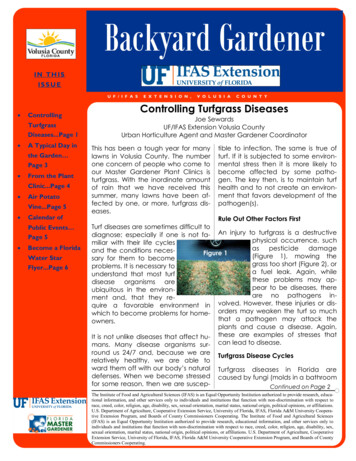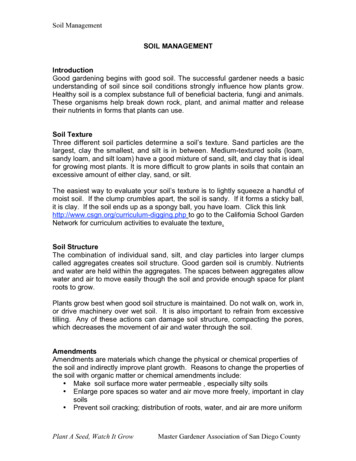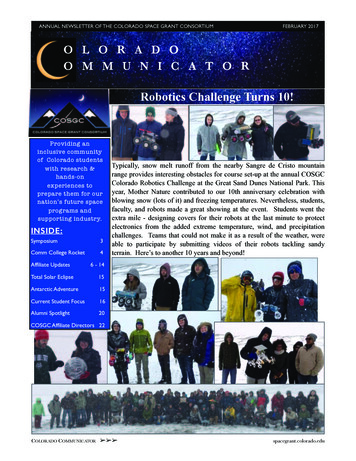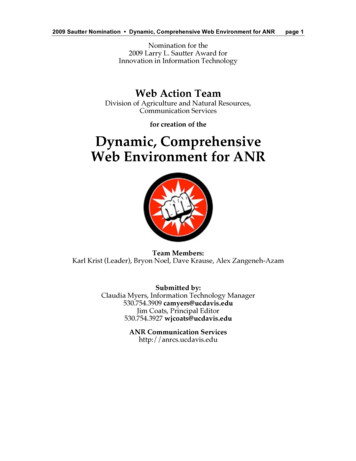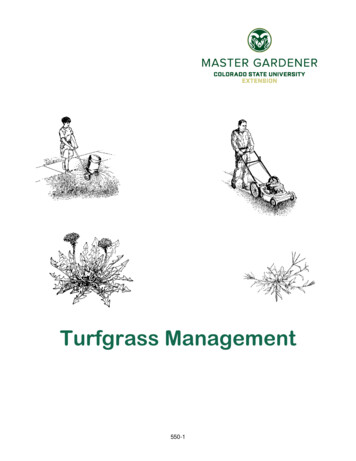
Transcription
Turfgrass Management550-1
Learning ObjectivesAt the end of class, the student will be able to: Describe how lawn management practices influence turf quality and why incorrect managementdecisions lead to common lawn care problems.Describe which grass species are best-adapted for lawn use, and the most important factors to considerwhen choosing a species for a new lawn (or when renovating an existing lawn)Describe how mowing height and frequency affect the aesthetic quality and stress tolerance ofturfgrass; why grass clippings should be recycled back to the lawn during mowing.Describe why nitrogen is the most important nutrient in a lawn fertilization program, how and when tofertilize a lawn, and how to select the appropriate lawn fertilizer.Describe the environmental factors affecting turf water use and how to use that knowledge to mosteffectively irrigate a lawn (how MUCH water to apply, and how OFTEN?).Describe thatch, understand why it forms in the lawn, what common problems its accumulation maycause, and how thatch is most effectively managed.Describe the negative effects of soil compaction on turf health and how to improve soil physicalconditions by using common cultivation practices.Describe how to establish a new lawn, using seed, sod or plugs. What is meant by lawn renovation andhow this process can be used to improve the quality of an existing lawn.Describe the most common lawn weeds, why weeds occur in the lawn, and how to most effectivelymanage weeds using cultural practices and, if necessary, herbicides.Describe the process of diagnosing common lawn problems and know where to find the most usefulresources (books, websites) to assist in the diagnostic processCMG volunteers approach diagnostic situations as a process. Students will be able to:o Describe concepts of Plant Health Care (PHC; IPM as it applies to lawn care)o Outline the life cycle of a lawn and describe how lawn/turf needs change with the age of thelawno List steps in the diagnostic processo Using the diagnostic process, diagnose routine lawn pest problemsTurfgrass Management curriculum developed by Tony Koski, Extension Turf Specialist, Department ofHorticulture and Landscape Architecture, Colorado State UniversityTony Koski, Ph.D.Extension Turf SpecialistDepartment of Horticulture and LAPhone: 970-491-7070E-mail: tony.koski@colostate.eduoooooColorado Master Gardener Training is made possible, in part, by a grant from the Colorado Garden Show, Inc.Colorado State University, U.S. Department of Agriculture and Colorado counties cooperating.Extension programs are available to all without discrimination.No endorsement of products named is intended, nor is criticism implied of products not mentioned.Copyright Colorado Master Gardener Program, Colorado State University Extension. All Rights Reserved. Training packetmay not be reproduced without written permission of Tony KoskiRevised January 2012550-2
ReferencesColorado State University ExtensionGrass Species Selection for the Home LawnCMG GardenNotesoooooooBest Turf Varieties: Variety Recommendations for Bluegrasses, Tall Fescues, Fine FescuesRyegrasses, and Buffalograss – #562Buffalograss Lawns – #565Fine Fescue Lawns – #564Hybrid (Kentucky X Texas) Bluegrasses for Turf Use in Colorado – #563Native Grass Lawns – #567Sources of Grass Seed, Sod and Plugs for Colorado Lawns – #566Turfgrass Species Selection Guidelines – #561MowingExtension Fact SheetsooLawn Care - #7.202Eliminate Grass Clipping Collection - #7.007Lawn FertilizationExtension Fact SheetsoooooooLawn Care - #7.202Nitrogen Sources and Transformations – #0.550Organic Materials as Nitrogen Fertilizers – #0.546Soil Testing – #0.501Soil Testing – Selecting an Analytical Laboratory – #0.520Soil Testing – Soil Test Explanation – #0.502Soil Testing – Soil, water and plant testing – #0.507Lawn IrrigationExtension Fact SheetsooooLawn Care - #7.202Irrigation: Inspecting and Correcting Turf Irrigation Systems - #4.722Watering Established Lawns - #7.199Operating and Maintaining a Home Irrigation System - #7.239Thatch and Compaction ManagementoLawn Care - #7.202Lawn Establishment and RenovationExtension Fact SheetsoLawn Care - #7.202550-3
oRenovating the Home Lawn - #7.241CSU TurfNotesoLawn Renovation: Terminology and Guidelines - #820Turf Weed ManagementExtension Fact SheetsooLawn Care – #7.202Control of Weedy Grasses in Home Lawns – #3.101Books Integrated Turfgrass Management for the Northern Great Plains. 1997. Baxendale, F.P. and Gaussoin,R.E. (eds.) University of Nebraska. Publication EC97-1557. 236 pages. Fundamentals of Turfgrass Management. 2003. Christians, N.E. John Wiley & Sons. 368 pages. 2ndedition. Identifying Turf and Weedy Grasses of the Northern United States. 2005. Pederson, D. and Voigt, T.University of Illinois Extension. 63 pages. Publication C1393. http://www.pubsplus.uiuc.edu Lawns: Your Guide to a Beautiful Yard. (2002 and 2007). Christians, N., Ritchie, A. and Mellor, D.Meredith Publishing. 1st edition ISBN 0696212706; 2nd edition ISBN 9780696229695. Weeds of the West. 1991. The University of Wyoming. 630 pages.Review Questions8. What grass can I plant if I don’t want to mow mylawn very often?Turfgrass Species/Variety Selection1. What is the best grass to plant in Coloradolawns?9. I would like to have a backyard putting green.What kind of grass is used?2. What is the best grass to plant if you don’t wantto water a lawn?Mowing the Lawn3. What grass can grow with only a “little”irrigation?1. What is the best mowing height for lawns?4. Can zoysiagrass grow in Colorado? What willhappen if I plant it anyway?2. My neighbor mows their lawn 2 or 3 times aweek. I mow only on Saturday morning. Who isright?5. What is the best grass for a shady lawn?6. Which grass grows best in salty soil?3. Should I mow higher or lower during thesummer?7. What is the best grass to plant over my septicleach field?4. Will I have less turf disease if I mow my lawnshorter in the fall, just before winter?550-4
5. Shouldn’t grass clippings be collected becausethey create thatch in lawns?6. My lawn gets a brownish cast after I mow. Whatis the problem?7. I see wheel marks in my lawn after it is mowed.What causes this to happen?8. How should I mow my lawn when it gets verytall?9. Do I have to buy a mulching mower to return mygrass clippings?10. What is the best mower? Rotary or reel?11. Can I compost my grass clippings, or use them asmulch, in my gardens?Lawn Fertilization1. What is the best fertilizer for my lawn?2. How often should I fertilize my lawn?3. How important is it to use a “complete” lawnfertilizer?4. Is liquid lawn care better (or worse?) thandry/granular lawn care?5. How do I know if I am applying the correctamount of fertilizer to my lawn?6. Should I “winterize” my lawn? What does thatmean, and what does it do for my lawn?7. Is it OK to fertilize after aerifying my lawn?8. Isn’t organic fertilizer better for my lawn thansynthetic fertilizer?9. Will I have to fertilize more or less if I leave mygrass clippings on the lawn?10. Should the fertilizer that I use have iron in it?11. Should sulfur be used to lower a lawn’s pH?550-5
Lawn Irrigation7. What is the best time of the year to aerate a lawn?1. Doesn’t Kentucky bluegrass need more waterthan all other lawn grasses?8. How many times per year should a lawn beaerified?2. For how long should I run my sprinkler system?9. How deep should the aeration core holes be?3. Is it OK to water my lawn every 3-5 days, eventhough my neighbors water their lawns everyday?10. What should I do with all of those plugs that theaerifier pulls out?11. Should I topdress the lawn with something to fillin the aerification holes?4. Is it bad to water my lawn every day?5. Will I get “fungus” if I water at night?12. Does wearing golf spikes aerify my lawn? Whatabout “lawn aeration sandals”?6. At what time of the day is it best to water mylawn?7. Should I water my lawn in the winter?Lawn Establishment and Renovation8. I have brown spots in my lawn, even though Iwater every other day. What is causing these dryspots?1. Is it better to seed or sod a new lawn?2. What time of the year can lawns be sodded?9. My new tall fescue lawn (which is supposed tosave water) seems to need as much water as myold bluegrass lawn. What is the problem?3. When is the best time to seed a lawn?4. Does soil really need to be tilled before plantinga new lawn?10. How should I water my newly seeded/soddedlawn?5. Should I bring in topsoil before I plant my newlawn?11. Should I water my lawn after I fertilize it?6. Before planting my new lawn, how much sandshould I add to my soil to loosen it up andimprove its drainage?12. Should I ever water my buffalograss lawn?7. How important is it to amend soil before plantinga lawn?Thatch and Compaction Management1. What is thatch?8. What is the best soil amendment?2. Why do my neighbors’ lawns NEVER seem toget thatchy, while mine always seems to be thatway?9. Is hydroseeding a good way to start a lawn?3. Can I topdress my lawn to get rid of thatch?10. Is “plugging” a good way to start a buffalograsslawn? How does it work?4. Do power rakes (dethatchers) work well?11. Does “overseeding” help a lawn in any way?5. Are there any liquid or granular “dethatching”products that work? How about ones which claimto relieve soil compaction?12. When is the best time to overseed a lawn?13. Is there a way to start a new lawn without goingthrough the process of removing old sod andtilling the soil?6. What are some symptoms of soil compaction in alawn?550-6
14. How does lawn renovation differ from starting anew lawn from scratch?2. I have high and low spots in my lawn. How can Ilevel them out?Weed Management in Lawns3. Will my lawn care companies mowers andaerifiers bring diseases into my lawn from otherlawns?1. Where do lawn weeds come from? How do theyget into a lawn?4. When should I do soil testing on my lawn?5. If I want to expand my garden areas, what is thebest way to kill off areas of my lawn?2. How do I get rid of the crabgrass in my lawn?3. Is it important to identify lawn weeds beforespraying them with a herbicide? Why?6. Is it OK to flood a part of my lawn to make askating/hockey rink for my children?4. I used a preemergence herbicide this spring and Istill have weeds. What went wrong?7. Can I empty the water from my swimming poolonto my lawn without killing the grass?5. Can I aerify or dethatch my lawn after I apply mypreemergence herbicide?8. How long can grass seed last if I don’t use all ofit?6. What is the best way to get rid of dandelions?Can I use a preemergence herbicide fordandelions?9. What kind of grass do I have growing in mylawn? How can I find out?10. My lawn is “lumpy”, but my neighbor’s is not.What causes the lumps, and why do I have them?7. Is it OK to pull weeds?8. Do “weed-and-feed” products work well?9. Are there any “organic” or “natural” weedcontrol products that work?Plant Health Care and the Diagnostic Process1. Define IPM and PHC.10. What is the best way to control weeds in mynewly seeded lawn?2. Describe concepts central to PHC?11. Weeds have come up in the “seams” in my newlawn. Should the sod company replace the sod?3. Give examples of common PHC tools used inhome lawn care.12. What is the best time of the year to spray forweeds?4. What is the PIC cycle? What does it explainabout lawn problems?13. What is the best herbicide to spray for dandelionsand other broadleaf weeds?5. In diagnosing contributing disorders, why is itimportant to also identify the predisposing andinciting factors to the extent possible?14. Is it better to spray the entire lawn, or just spottreat individual weeds? Won’t I miss some weedsif I spot-treat?6. List the four steps in the diagnostic process.7. Give examples of BIOTIC (living) factors thatcause turf problems.15. Is it OK to spray lawn weeds growing under mytrees? Will the trees be OK?8. Give examples of non-living (abiotic) factors thatcause lawn problems.Miscellaneous Lawn Questions9. Why is it important to correctly identify the turfspecies in a lawn that is having problems?1. How do I take care of “dog spots” in my lawn?550-7
10. Why is it important to look at the ENTIRElandscape (trees, flowers) when diagnosing alawn problem?10. Define symptom and sign. Give examples ofeach.11. Explain why it is important to understand what isnormal versus abnormal when dealing with lawnproblems?11. Why look to see if the problem is occurring in theback yard/front yard as well – or in neighboringlawns? What can that tell you?12. Why is it important to know the AGE of a lawnas part of the diagnostic process?12. What kind of tests can be done to determinewhether or not chemical injury has occurred on alawn?13. Why is it important to “start from scratch” withevery diagnostic situation?Diagnosing Biotic Pest Problems on LawnsDiagnosing Abiotic Lawn Disorders1. List the four steps in the diagnostic process.1. Explain how knowing the context of the situationhelps in diagnosing the disorder.2. What is the “disease triangle” and how does itapply to diagnosing lawn disease problems?2. Explain how painting a mental picture of a lawnproblem helps in diagnosing a disorder.3. What percentage of summer lawn problems inColorado are related to irrigationamount/frequency, or other aspects of lawnirrigation?3. Explain how repeating back the details in yourown words helps in diagnosing a disorder.4. Explain how to tactfully change directions with aclient when the evidence for the cause of a lawnproblem leads down another road.4. If a client tells you that they get the SAMEproblem every year, in the same part of the lawn,what are some potential causes of the lawnproblem?5. Why is it important to discuss managementoptions ONLY after the problems have beendiagnosed?5. What is the proper way to obtain a sample of turffor diagnostic purposes? How should it be storedand transported?6. In the landscape setting, what is the universallimiting factor for root growth?6. What do you tell a client who believes that“fungus” has been tracked onto their lawn by alawn care company’s mowing or aerationequipment?7. What percentage of lawn problems are related toroot/soil/water issues?8. Describe techniques to evaluate soil/rootdisorders and soil compaction.9. Why is it important to know if a client uses aprofessional lawn care company, or is a do-ityourselfer?550-8
CMG GardenNotes #551Basic Turf ManagementOutline:Reason for lawn problems, page 1Mowing, page 1Lawn clipping and surface water pollution, page 2Fertilization, page 3Selecting a lawn fertilizer, page 3When and how much to apply, page 4Fertilizer and water pollution, page 5Irrigation, page 6How much water?, page 6How often should a lawn be watered?, page 7What are some signs that turf need to be watered?, page 7Thatch, page 8Power raking for thatch management, page 9Core cultivation or aerating, page 9Soil compaction, page 9Weed management, page 10Insect and disease management, page 11Reasons for Lawn Problems Although there are many specific reasons to which one could attribute lawnproblems, the most common general reasons include: Poor management decisions (soil compaction, improper mowing,irrigation, fertilization, pest management)Using poorly adapted species or cultivars. Limitations in resources (water,time/labor, dollars)MowingThe two most important facets of mowing are mowing height and frequency. Thepreferred height for all species in a lawn is two and half to three inches. Mowingto less than two inches can result in decreased drought and heat tolerance (due toshallow rooting and reduced photosynthesis) and encouraged weed invasion.Higher encourages insects, diseases, and weeds. Mow the lawn at the same heightall year. There is no reason to mow the turf shorter in late summer or in the fall.551-1
Mow the turf often enough so no more than one-third of the grass height isremoved at any single mowing. This may mean mowing a bluegrass or fescuelawn every three to four days during the active spring growth period, but only onceevery seven to 10 days at other times of the year when growth is slowed by heat,drought or cold. If weather or another factor prevents mowing at the proper time,raise the height of the mowertemporarily to avoid cutting toomuch at one time. Cut the grassagain a few days later at thenormal mowing height. [Figure1]Figure 1. Mow oftenenough that no more than1/3 of the grass height isremoved in any singlemowing.Let grass clippings fall back onto the lawn while mowing, unless they are to beused for mulching elsewhere in the landscape. Grass clippings decompose quicklyand provide a source of recycled nutrients (equivalent to 1 to 1½ fertilizations peryear) and organic matter for the lawn. Although a mulching or recycling mowermakes this easier to do, clippings can be recycled into the lawn using any mower(as long as the 1/3 rule of mowing frequency is used). Grass clippings do notcontribute to thatch accumulation.Lawn Clippings and Surface Water PollutionLawn clippings and leaves mowed, swept, or blown onto the street are the majorsource of phosphorus pollution in urban lakes and streams. With side dischargelawnmowers, mow in a direction to prevent clippings from being blown onto thestreet, driveway, and other hardsurfaces. Do not sweep orblow lawn clippings into thegutter and street. [Figures 2and 3]Figure 2. In a Minnesotastudy, 60 to 80% of thephosphate loading ofsurface water in an urbansetting came from lawnclippings and leaves thatwere mowed or blowninto the streets.Figure 3. When mowing the lawn, mowin a direction to prevent clippings frombeing blown into the street.551-2
Also, leave an unmowedgrass buffer strip edging anylakes, streams, ponds, andwetlands. [Figure 4]Figure 4. To reducesurface water pollution,leave an unmowedbuffer strip aroundlakes, streams andponds.In a natural setting, rain and snowmelt absorbs mostly into the soil. Air-bornepollutants and pollen washed out of the air are broken down by soil microorganismactivity. The nitrogen and phosphorus released from the decay of grass, leaves,and other organic matter recycle back into the soil.However, in the landscape setting, the water cycle is greatly changed by largeareas covered by hard surfaces (streets, driveways, walks, parking lots, compactedsoils, and buildings). In a typical landscape setting 55% of a rainfall moves assurface runoff, compared to only 10% in a naturalized setting. Nutrients fromgrass and leaves (along with fertilizers, pesticides, and other water-solublepollutants) readily wash off the hard surfaces into the storm sewer system. Herethe pollutants end up in local streams, ponds, and lakes.FertilizationSelecting a Lawn FertilizerNitrogen (N) is the most important nutrient for promoting good turf color andgrowth. However, do not over-stimulate the turf with excess nitrogen, especiallyduring the spring and summer. Over-fertilization can contribute to thatch buildupwith some species, as well as increased mowing and irrigation requirements.Under-fertilization of some species (bluegrass and ryegrass, for example) canresult in poor turf color and turf thinning, which can encourage weed and diseaseproblems. Turf species differ in both the amount of nitrogen required to keep themhealthy, as well as the best time of the year to fertilize them.Balanced or complete fertilizers contain various amounts of phosphorus,potassium, iron, and sulfur. They are a good safeguard against a potential nutrientdeficiency and there is no harm in using a “complete” fertilizer. However, if youleave clippings on the lawn, these nutrients are recycled back into the lawn, sothere is little likelihood of seeing these deficiencies. Besides nitrogen, the mostcommonly deficient nutrient in lawns is iron (Fe).Organic fertilizers will work as effectively as synthetic types. However, it isimportant to understand the release characteristics of the different fertilizers so thatthey can be used at the correct times of the year. Organic fertilizers typicallyrelease nutrients more effectively when soils are warm and moist. Many synthetic551-3
types work well when soils are cooler, but some synthetic types work like thenatural organic sources.Better lawn fertilizers include a quick release form of nitrogen for quick green-up,plus slow-release forms of nitrogen for sustained greening. Examples are listed inTable 1.Table 1. Example of Quick and Slow Release FertilizersQuick-Release Nitrogenfor fast green-upSlow-Release Nitrogenfor sustained greenAmmonium sulfateAmmonium nitratePotassium nitrateUreaResin-coated ureaSulfur-coated ureaIsobutylidene diurea (IBDU)Methylene ureaUrea formaldehydeCompost and manurePoultry wastePoultry feathersWhen to Fertilize and How Much to ApplyThe natural grass growth cycleinfluences proper fertilizationtime for lawns. Figure 5illustrates typical root and shootgrowth patterns of cool seasonturfgrass species. [Figure 5]Figure 5. Growth cycle of roots and shoots for cool season turf.Figure 6 on the right illustratesthe influence on shoot growthwhen nitrogen fertilizer isapplied. Heavy springfertilization promotes shootgrowth, reducing carbohydrateenergy reserves and stresstolerance. [Figure 6]Figure 6. Influence on shoot growth for nitrogen fertilization.Benefits of Fall Fertilization on Cool Season Home Lawns Enhances storage of carbohydrate energy reservesStrengthens root systemIncreases shoot densityIncreases stress toleranceBetter fall and winter colorEarlier green-up in spring551-4
Timing and Application RateTiming and application rates are given in Table 2. If lawn clippings are returned tothe lawn, reduce application rate by ¼ to 1/3.Table 2. Fertilizer Application Schedule for Established Colorado Lawns1, 2Turfgrass speciesMid-Marchto April3May tomid-JuneJuly to earlyAugustMid-August tomid-SeptemberEarly Octoberto earlyNovember4(Nitrogen application rates are in pounds of nitrogen per 1,000 square feet of lawn area.)CoolSeasonSpeciesWarmSeasonSpeciesHigh maintenanceBluegrass andRyegrass½ to 11Not required11-(2)Low MaintenanceBluegrass½½-1Not required1(1)Turf-TypeTall Fescue½½-1Not required1(1)Turf-TypeFine Fescue½½-1Not required½-1Not requiredBuffalograss,Blue Grams, andBermudagrassApply no N½-1½-1Apply no NApply no N1 Nitrogen applications can often be reduced by 1/4/ to 1/3 when grass clipping are returned to the lawn during mowing.Nitrogen and other nutrients contained in the clippings are recycled to the lawn as they decompose. Grass clippings donot contribute to thatch accumulations in lawns.2 On sandy soils, use slow-release nitrogen fertilizers (sulfur-coated ureas, IBDU, and natural orgainic-based fertilizers)throughout the year to reduce the potential for leaching loss. On very sandy soils, do not fertilizer turf after late September.Nitrogen can leach into ground water during the winter months.3 The March-April nitrogen application may not be needed if fertilized in late fall (September to November) the previous years.If spring green-up and growth is satisfactory, delay fertilizing until May or June.4 Make the final fall nitrogen application (October-November) while the grass is still green and at least two to three weeksbefore the ground begins to freeze. Optional N applications shown in (). Use extra nitrogen applications where a higherquality turf is desired or on a heavily used turf.Fertilizers and Water PollutionHome lawn management techniques play a significant role in protecting orpolluting surface water. Popular press has incorrectly labeled lawns as a majorcontributor to water pollution. It is not the lawn, but rather the management styleof the gardener that become the problem.Fertilizers and pesticides (herbicides, insecticides, and fungicides) spread ontohard surfaces (driveways, sidewalks, streets, and compacted soils) will move withsurface water into neighboring lakes, streams, and ponds. (Surface water runningdown the street gutter is not treated before release into local lakes, streams, andponds.)551-5
However, phosphate fertilizer applied to a lawn or garden soil is bound to the soiland does NOT leach into ground water. The phosphate could move into surfacewater with soil erosion.Organic fertilizers are not necessarily safer for the environment. The pollutionpotential is based on where the fertilizer is applied and application rates. Anyfertilizer becomes a potential pollution problem when over-spread into hardsurfaces. Over application of both manufacture and organic fertilizers have beenlinked to ground water contamination.Potential pollution problems arise from the careless application rather than the typeof fertilizer applied. In most Western soils, lawns do not need phosphatefertilizers.IrrigationMany factors influence lawn water requirements, and no two lawns will haveexactly the same needs. Table 3 gives the typical water requirement (rain plusirrigation) per week. A healthy, high-quality bluegrass or ryegrass lawn mayrequire up to 2 to 2.25 inches of water per week under hot, dry, windy summerconditions; but may require much less when the weather is cool or cloudy. Turftype tall fescue may perform well with less irrigation than a bluegrass lawn, if itcan grow a deep root system and the soil in which it is growing is holding usablewater. In many cases, however, a tall fescue may require as much water asbluegrass to look good. [Table 1]Table 3.Typical Water Requirement (Rain Plus Irrigation) for Colorado LawnsInches of water per week(irrigation plus rain)LateAprilMay &JuneJuly &August0.75”1.0”1.5”EarlySeptember October1.0”0.75”Buffalograss and blue grama lawns can remain green for weeks without watering,even during the hottest summer weather, with rainfall.Shady lawns (not in the rooting zone of large trees) and areas protected from thewind require less water over the growing season than more exposed turf.However, the roots of mature trees and shrubs also need water. You may have towater more in mature landscapes where the roots of many plants compete forwater. Healthy turf encouraged by proper mowing, fertilizing, and cultivation,uses water more efficiently.551-6
How Much Water?Each time you water the lawn, apply enough water to moisten as much of the rootzone as possible. Use a soil probe or shovel to determine what the average rootingdepth is in your lawn. If the roots grow down 6 inches deep, water so the soil ismoistened to that depth. It is important to know not only how deep the turf rootsgrow, but also how deep your irrigation water penetrates. Watering too deeply,especially on sandy soils, wastes water and allows it to percolate past the rootzone. [Figure 7]Figure 7. Typical water (rain plusirrigation ) is given in Table 5.However, actual water use jumpsaround from day to day based ontemperature, wind, humidity, and solarradiation (sunny or cloudy).How Often Should a Lawn be Watered?Grass growing on a sandy soil must be watered more often than the same grassgrowing on clay or loam soils. Even after a thorough watering, sandy soils holdlittle plant-available moisture. They require more frequent irrigation with smalleramounts of water.Conversely, turf growing on clayey soils can be irrigated less frequently, withlarger quantities of water. Watering less often means more efficient water usebecause of less loss to evaporation. It can also reduce the number of weeds thatappear in the lawn. With most soils, do not apply all of the water in a short periodof time. If applied too quickly, water will run off of thatchy turf, from slopedareas, or from turf growing on heavy clay or compacted soils. In these cases, it ismore effective to apply only a portion of the water and move the sprinkler orswitch to another station to water another section of the lawn. Cycling throughirrigation stations (“soak cycles”) will promote infiltration and reduce runoff andpuddling in low spots. This allows water to soak into the soil rather than run off.Core cultivation (aeration) can resolve some infiltration problems by reducingthatch and compaction. Wetting agents may enhance water movement into thesoil, but they should not be considered a cure-all, especially when compaction andthatch are problems.What are Some Signs that Turf Needs to be Watered?A sure sign that turf requires irrigation is a wilted appearance. One symptom is“footprinting,” where footprints on the lawn that do not disappear within an houror so following traffic. This symptom is soon followed by actual wilting, where551-7
the turf takes on a grayish or purple-to-blue cast. If only a few such spots regularlyappear in the same general location, spot water them to delay watering the entirelawn for another day or so. These indicator spots help predict that the entire lawnwill soon need watering.A hardened or toughened lawn, attained through less frequent, deep irrigation,often withstands minor drought and generally has fewer disease problems. It isimportant, however, that the turf not be allowed to become overly drought-stressedbetween waterings. This weakens the turf and makes it more susceptible to insectand disease damage and to weed invasion.During extended dry periods from late fall to spring, it may be necessary to“winter water” every four to six weeks if the ground is thawed and will acceptwater. Pay particular attention to exposed slopes, sites with shallow soil, andsouth- or west-facing exposures, where winter mites may infest and kill droughtstressed turf during the winter and early spring.The most efficient time of day to water is late evening and early morning (between9 p.m. and 9 a,m.). It generally is less windy, cooler, and more humid at this time,resulting in less evaporation and more efficient use of water. Water pressure isgenerally better, optimizing sprinkler distribution patterns. Contrary to popularbelief, watering at night (after 9 p.m.) does not encourage disease development inturf.ThatchThatch is a tight, brown, spongy, organic layer of both living and dead grass rootsand stem
Horticulture and Landscape Architecture, Colorado State University . Tony Koski, Ph.D. Extension Turf Specialist . Department of Horticulture and LA . Phone: 970-491-7070 . E-mail: tony.koski@colostate.edu. o Colorado Master Gardener Training is made possible, in part, by a grant from the .
